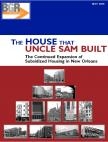In an interview with The Lens this afternoon, Janet Howard, president of the Bureau of Governmental Research stated that it would be “inaccurate” for someone to use their report The House That Uncle Sam Built: The Continued Expansion of Subsidized Housing in New Orleans to say there was too much subsidized housing. Even with testimony from people like Speaker of the House, Rep. Jim Tucker (R-Algiers) who stood by the BGR report in saying there was an “excess supply” of subsidized housing, Howard said “there is no takeaway from our report except that this is the supply,” period.
When asked if someone would be accurate in citing the BGR report as proof that there is too much affordable housing, Howard said, “That would be inaccurate because all we said is, ‘Here is what’s there,’ and we did not reach any conclusions on whether there is too much or too little affordable housing and we’ve never taken a position on it.”
BGR may have never directly said that New Orleans had too much public housing, but their report prompted a State Bond Commission hearing that led to a moratorium on approval of bonds for additional subsidized housing production. The press release for BGR’s housing report states how the number of subsidized rental units will more than double from pre-Katrina levels; will increase from 10% to 25% as a percentage of all housing; and will provide 3,600 more units than pre-Katrina levels.
“The dramatic projected increase in the volume and market share of subsidized housing in New Orleans underscores the importance of carefully analyzing this segment of the market and its potential impacts on the city as a whole,” reads the release.
The “Housing Production Needs” report released yesterday by the Greater New Orleans Community Data Center provided a different picture. It showed New Orleans without a doubt is not overstocked with affordable housing, and in fact is in need of more. GNOCDC deputy director and chief demographer Allison Plyer told The Lens:
“The data shows that there is not nearly enough affordable housing, and even if we build all of the units currently in the pipeline we still won’t have enough.”
But the report from GNOCDC mirrored BGR’s report in many ways. They both agree about the quantity of subsidized units in New Orleans, only they arrive at different conclusions. Howard said she had not read the GNOCDC report but couldn’t comment on it. The BGR report merely covered the supply side with no analysis of the demand. Plyer’s analysis of the demand demonstrates the lack of affordable housing, particularly for very low-income households, low-income ($20 – $35,000 salary), and not to mention the homeless.
At a GNOCDC presentation of their report, a suggestion was made as to whether the two organizations could release a joint statement about housing in lieu of their research. Howard said there has been “some discussion” about that at BGR, but also said she received no request from GNOCDC about this (Plyer told The Lens she asked BGR representatives at the presentation about a joint statement, and was told they’d have to check with Howard). However, Howard also said, “We’re not in the business of signing off on other people’s research.”
But policymakers like Rep. Tucker are signing off on BGR’s research to hold up funds dedicated for creating affordable housing. And now Tucker is looking to divert funds from Louisiana Recovery Authority that are purposed for building new apartments to go to programs for repairing roads and blight. Howard says they have no control over how people use the information in their reports but, but people like Tucker and Donald Vallee, former president of the New Orleans Landlords Association, have trumpeted the BGR report in ways that are leading to housing funds being rerouted elsewhere. If Howard really believes that it would be inaccurate for anyone to use their research as a way of proving there’s too much subsidized housing one wouldn’t know because she is refusing so speak up when it happens.
— Brentin Mock

